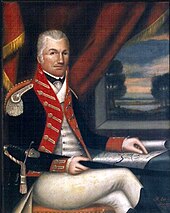42°59′52″N 79°10′30″W / 42.997895°N 79.174913°W / 42.997895; -79.174913
| This article needs additional citations for verification. Please help improve this article by adding citations to reliable sources. Unsourced material may be challenged and removed. Find sources: "Battle of Cook's Mills" – news · newspapers · books · scholar · JSTOR (August 2008) (Learn how and when to remove this message) |
| Battle of Cook's Mills | |||||||
|---|---|---|---|---|---|---|---|
| Part of the War of 1812 | |||||||
 The monument commemorating the battle. | |||||||
| |||||||
| Belligerents | |||||||
|
|
| ||||||
| Commanders and leaders | |||||||
| Christopher Myers |
George Izard Daniel Bissell | ||||||
| Strength | |||||||
|
750 | 1,200 | ||||||
| Casualties and losses | |||||||
|
1 dead, 35 wounded |
12 dead, | ||||||
| National Historic Site of Canada | |||||||
| Official name | Battle of Cook's Mills National Historic Site of Canada | ||||||
| Designated | 1921 | ||||||
The Battle of Cook's Mills was the last engagement between U.S. and British armies in the Niagara, and the penultimate engagement (followed by the Battle of Malcolm's Mills) on Canadian soil during the War of 1812. After a battle lasting less than an hour, American forces out-maneuvered the British column, and later destroyed all grain found in the mill.
Background
General Gordon Drummond had lifted the Siege of Fort Erie on 21 September 1814, and withdrew to a strong defensive position at Fort Chippawa on the north bank of Chippawa Creek. An American division under Major General George Izard had marched overland from Plattsburgh, New York to reinforce the Americans at Fort Erie (commanded by Major General Jacob Brown). Being the senior Major General, Izard took command of the combined force. The more aggressive Brown wished to attack Drummond immediately, with the combined force numbering 6,300. Izard chose not to risk the casualties of attacking a strong defensive position. Angered at Izard's lack of action, Brown left with his division (half the army's strength) and marched to Sacketts Harbor, New York, where a British attack was feared.
Izard finally marched north to Chippawa Creek. The creek was unfordable, and the bridge had been destroyed. During 16 October, his artillery exchanged fire with the British, without effect.
Battle

| Niagara Frontier | |
|---|---|
|
Attempting to deprive the British of their chief source of flour, Izard sent a brigade of about 1,200 men, consisting of the 5th, 14th, 15th and 16th U.S. Infantry with some detachments of riflemen and U.S. Dragoons under Brigadier General Daniel Bissell, to take Cooks Mills on Lyon's Creek in Crowland township. In response, Drummond dispatched about 750 men (the 6th Regiment, the Glengarry Light Infantry and the flank companies of the 104th Regiment, with a 6-pounder gun and a Congreve rocket detachment) under Lieutenant Colonel Christopher Myers to reconnoitre the American force.
On the morning of 19 October, Myers came into contact with the American picket just east of the mills. A half-hour fight ensued, but the Americans could not be lured from the cover of the woods. Observing American soldiers moving through the trees on his right and left, Myers feared he was being out-manoeuvred. He eventually ordered an orderly retreat. The Americans pursued his column nearly to their camp at the Lyon's Creek settlement. Returning to Cooks Mills, the Americans destroyed all the grain found in the mill. Their dead, approximately a dozen soldiers, were interred in shallow pits at the Yokom farmhouse near the mills. The next day they withdrew to their camp at Black Creek.
Aftermath
The battle showed the effects of Izard's well trained troops. Despite this minor victory, it became apparent that Drummond was not going to move from his defences. Izard also heard that British ships dominated Lake Ontario, and any American advance risked being cut off by a landing in its rear. He withdrew to Fort Erie. The British loss of 200 bushels of wheat was offset when several American provision boats crossed the Niagara unaware of Izard's retreat and fell into British hands.
Izard later destroyed Fort Erie and returned to the U.S. side of the river. Drummond moved to the remains of the fort but chose not to rebuild it, and the fighting along the Niagara Frontier came to an end.
The site of the battle was designated a National Historic Site in 1921, and is a unit of the national park system. A federal cairn were erected in 1923, and the current plaque replaced the original on the cairn in 1977. Bicentennial commemorations in 2014 included construction of a visitors’ plaza and the unveiling of interpretive markers.
Eight active regular battalions of the United States Army (1-2 Inf, 2-2 Inf, 1-3 Inf, 2-3 Inf, 4-3 Inf, 1-4 Inf, 2-4 Inf and 3-4 Inf) perpetuate the lineages of a number of American infantry regiments (the old 5th, 14th and 16th Infantry Regiments) that took part in the battle.
Notes
- Ernest Cruikshank. "The Documentary History of the campaign upon the Niagara frontier. [Part 1-2]". University of Calgary. p. 257. Archived from the original on March 7, 2012. Retrieved October 20, 2009.
- Battle of Cook's Mills. Directory of Federal Heritage Designations. Parks Canada. Retrieved 17 October 2014.
- Battle of Cook's Mills. Canadian Register of Historic Places. Retrieved 17 October 2014. s
Sources
- Heidler, David; Heidler, Jeanne, editors Encyclopedia of the War of 1812
- War of 1812 site
| National Historic Sites of Canada by location | |
|---|---|
| Provinces | |
| Territories | |
| Other countries | |